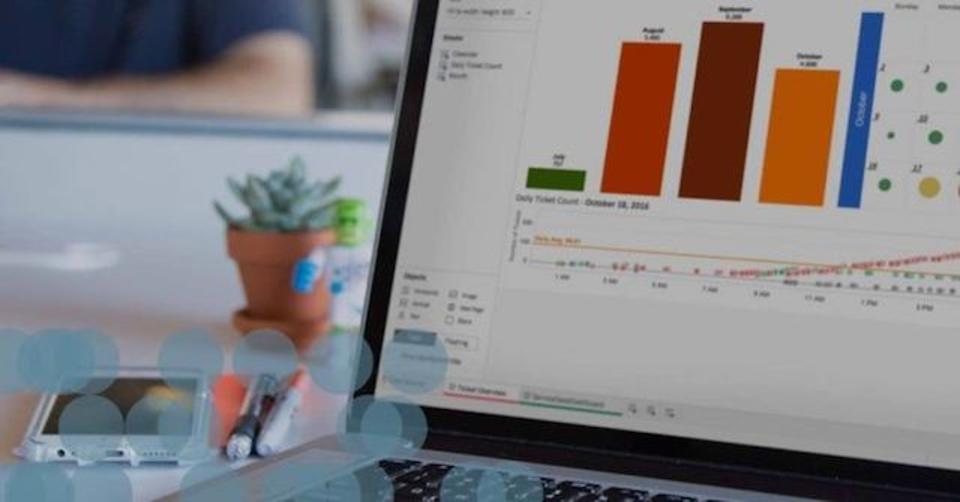Simpler to use than database query language (and easier to look at too).
Adrian Bridgwater , CONTRIBUTOR
Data visualization company Tableau Software has acquired ClearGraph, a Palo Alto startup that produces what it calls ‘data discovery’ and analysis technology that works through spoken ‘natural language’ queries. There’s an almost mirror-like balance to what is going on here, so what do these two firms actually make?
Data: easier out, easier in?
Tableau’s technology allows users to graphically visualize data held inside databases. That means users don’t just have to look at columns and rows, they can more easily see trends in data when it is represented by heat maps, pie charts, scatter plots, gantts, and bubble charts. Equally, for users that aren’t skilled in how to run database queries, ClearGraph’s technology allows users to query data using the spoken word.
With Tableau now integrating ClearGraph into its own IT stack, this is a kind of easier out (using interactive visualizations) and easier in (using simple voice commands) approach to how to work with database information.
“We founded ClearGraph because we saw a need to bridge the gap between humans and computers through natural language, especially when it comes to exploring data,” said Andrew Vigneault, CEO of ClearGraph. “Tableau is a natural fit for us because we have similar missions, cultures and a genuine desire to help more people around the world access, interact with and get answers from their data.”
The most recent updates from Tableau saw the firm upping the machine learning abilities of its data visualization tools i.e. if a user (perhaps one without a statistically-gifted brain) isn’t sure what kinds of trends they should be looking for in the data graphics they are looking at, then the system itself will start suggesting metrics that could be worth tracking. For the firm to buy ClearGraph and put natural language queries into its total offering, this almost flows in a similar vein i.e. it’s another extension to make big data analytics accessible to people outside the database engineering department itself.
But what is (arguably) most interesting of all is the way this technology will deliver computational linguistics inside the context of semantic inference-based natural language interfaces. That sounds complex, but it’s not… it’s all about how well we humans present our spoken queries to computers.
Humans speak with ‘too much meaning’
If we ask a computer system the price of BMWs for sale in the state of Maryland, it’s logical reply will include ALL possible answers. We might more logically want to know the price of cars that are either used or new. We might want to filter out cars that are more than two hours journey away. We might also want to set a certain price bracket. How about color? What about interiors? The problem is that there is ‘too much meaning’ in our original query. So the only way of asking for this query accurately would be to say: ‘give me the details of BMWs in Maryland within a radius of 100 miles under $20,000 excluding any with yellow paint jobs’… and even then we haven’t managed to specify leather interiors. This is where the most recent advances in natural language computing also have an appreciation for human ‘intent’ so that queries can be automatically narrowed and refined before they are delivered.
Accessing and analyzing data using ClearGraph requires no technical training, as the system can infer users’ intent. For example, people could ask questions such as, “Total sales by customers who purchased staples in New York,” then filter to, “orders in the last 30 days,” then group by, “project owner’s department” for example.
Tableau is saying that ClearGraph brings a consumer-like experience to users by connecting disparate data sources and making them accessible and intelligible through simple conversational style search. ClearGraph’s natural language query technology stores semantic data in knowledge graphs that can expand and learn over time.
“We are thrilled to bring the ClearGraph team to Tableau to enable people to ask questions of their data using natural language,” said Francois Ajenstat, chief product officer at Tableau. “Natural language queries will make it easier for more people to interact with Tableau, whether you’re an executive who needs an answer quickly, or on a mobile phone and want an answer from your data on the move. We’re excited about this acquisition as the ClearGraph team shares our mission and is aligned with our innovation perspectives on conversational analytics.”
Will Tableau worry Microsoft or Oracle?
Will Tableau win over fans of Microsoft Power BI and leave Redmond fuming with this the (only) third acquisition in its company history? Could firms who are not sold into the Microsoft Azure cloud computing stack see this as a way of getting easier access to database query and analysis tools to use across a wider transept of computing platforms?
Yes, a bit, somewhat, but not enough to a cause too many ructions in Redmond or indeed inside the hallowed halls of Oracle’s inner sanctum.
Instead, we might reasonably argue that this logical enough acquisition will strengthen and diversify Tableau’s own customer base who will now get some extra smart tools and help more users to start getting exposed to data analytics. It’s a big (smart) Business Intelligence pie and there’s enough for several cooks to stir this cauldron.
[/fusion_text][fusion_text animation_direction=”left” animation_speed=”0.3″ animation_delay=”0″ hide_on_mobile=”small-visibility,medium-visibility,large-visibility” sticky_display=”normal,sticky”]
Curious to know more? Schedule a consultation with Thinklytics to know more about how data analytics can make your life easier and make you a hero at work.








